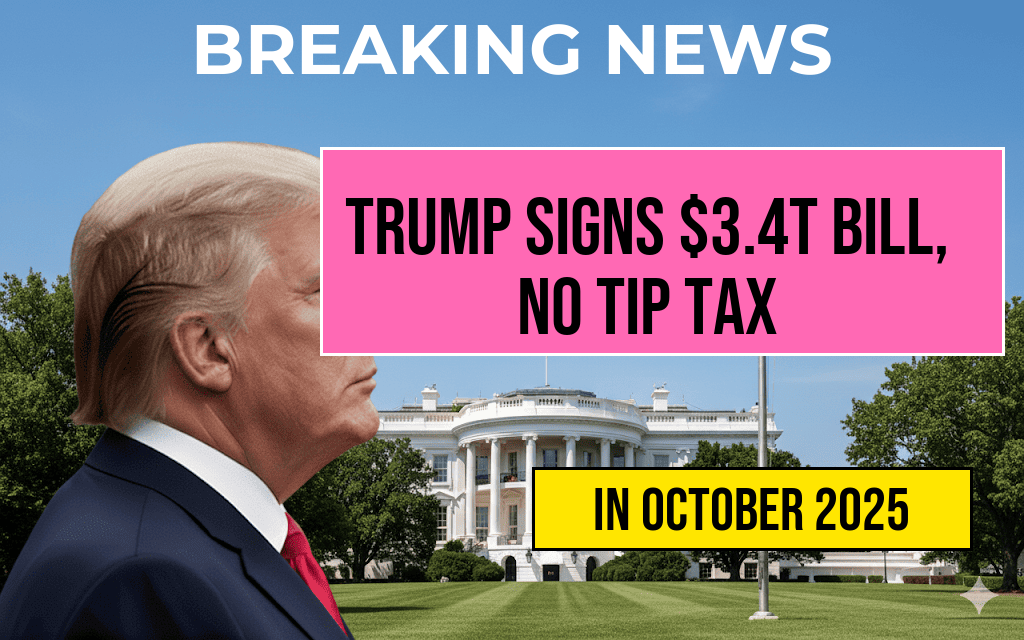President Trump Signs $3.4 Trillion Mega-Bill Amid Record $4 Trillion Debt Increase, Affirms No Tax on Tips
President Donald Trump has officially enacted a substantial legislative package totaling $3.4 trillion, marking one of the largest fiscal measures in recent U.S. history. The bill, passed through congressional approval late last week, is projected to significantly expand federal spending across multiple sectors, including infrastructure, healthcare, and defense. Accompanying this move, the national debt is anticipated to swell by roughly $4 trillion, raising concerns among economists and lawmakers about the long-term fiscal sustainability of such large-scale borrowing.
Despite the expansive scope of the bill and the increase in national debt, President Trump reaffirmed his stance against implementing new taxes on small transactions, notably emphasizing that **tips will remain untaxed**. This pledge aims to appease small business owners and service industry workers, while also positioning the administration as protective of low-income earners. The legislation’s passage has ignited a flurry of debates across political aisles about fiscal responsibility, economic growth, and social equity.
Details of the Mega-Bill and Its Components
The $3.4 trillion legislation encompasses a broad array of initiatives designed to stimulate economic activity and address persistent infrastructural deficits. Key provisions include:
- Infrastructure Investment: $1.2 trillion allocated for roads, bridges, and public transportation projects.
- Healthcare Funding: $650 billion directed toward expanding Medicaid and improving healthcare access.
- Defense and National Security: $850 billion dedicated to military modernization and cybersecurity efforts.
- Education and Workforce Development: $400 billion for school modernization and job training programs.
- Climate Initiatives: $200 billion for renewable energy projects and climate resilience measures.
The bill also includes targeted relief measures aimed at small businesses and low-income families, seeking to bolster economic recovery amid ongoing pandemic-related challenges.
Fiscal Impact and Rising National Debt
The legislative package’s financing is projected to increase the federal deficit by approximately $4 trillion over the next decade. This surge reflects the combination of new spending and the estimated decline in revenue due to existing tax cuts. Experts warn that such a significant debt increase could impact the country’s credit rating and borrowing costs in the future.
According to the Congressional Budget Office (CBO), the bill’s enactment will push the national debt to levels unseen since World War II, with debt-to-GDP ratios approaching critical thresholds. While proponents argue that the investment will generate economic growth that offsets the debt increase, skeptics caution about the risks of fiscal overreach and future inflationary pressures.
Tax Policy Stance and Tips
Amid debates over funding and fiscal responsibility, President Trump reiterated his commitment to keeping **taxes on tips**, a move designed to preserve income for service workers and small businesses. During a press conference, the president stated, “We are not raising taxes on tips or small transactions. We understand the importance of supporting our hardworking Americans, especially those earning tips every day.”
This stance aligns with the administration’s broader approach to minimize tax burdens on low- and middle-income Americans, contrasting with proposals from opposition parties that seek to increase taxes on the wealthy and corporations to fund social programs.
Political and Economic Reactions
The bill’s passage has elicited mixed reactions among political leaders and economic analysts:
Supporters’ Viewpoints
- Argue that the infrastructure and social investments will catalyze economic growth.
- Claim that targeted spending can modernize the economy and improve quality of life.
- Emphasize the importance of maintaining tax policies favorable to small earners.
Critics’ Concerns
- Warn that increased borrowing could lead to higher interest rates and inflation.
- Question the long-term sustainability of such expansive fiscal policies.
- Express concern over the potential for future tax hikes to offset current benefits.
Economists from institutions like the Brookings Institution and the Heritage Foundation have issued statements emphasizing the need for careful fiscal planning moving forward.
Implications for Future Policy and Economy
The legislation signals a significant shift in fiscal strategy, emphasizing large-scale government spending as a tool for economic recovery. However, the substantial increase in debt raises questions about the U.S. economy’s ability to service its obligations without affecting future investments or increasing taxes.
As markets respond to the bill’s passage, analysts are closely watching interest rate movements and credit ratings. The Biden administration’s recent fiscal policies have shown a focus on balancing growth with deficit control, but the Trump administration’s latest measures seem to prioritize immediate economic stimulus.
Sources and Further Reading
- National debt of the United States – Wikipedia
- Forbes – Impact of Large Fiscal Legislation on the U.S. Economy
Frequently Asked Questions
What is the total value of the mega-bill signed by Trump?
The mega-bill signed by Trump is valued at $3.4 trillion.
How much is the debt increase associated with this legislation?
The legislation is projected to cause a $4 trillion increase in the national debt.
Did Trump pledge to tax tips?
Yes, Trump pledged no tax on tips, ensuring that workers who earn tips are not taxed on this income.
What are the main purposes of the mega-bill?
The mega-bill aims to address various economic and fiscal priorities, including spending increases and tax policies.
How has the public reacted to the signing of this mega-bill?
Reactions vary, with some supporters praising the legislation for its economic impact, while opponents express concerns about the debt increase and tax policies.

Leave a Reply